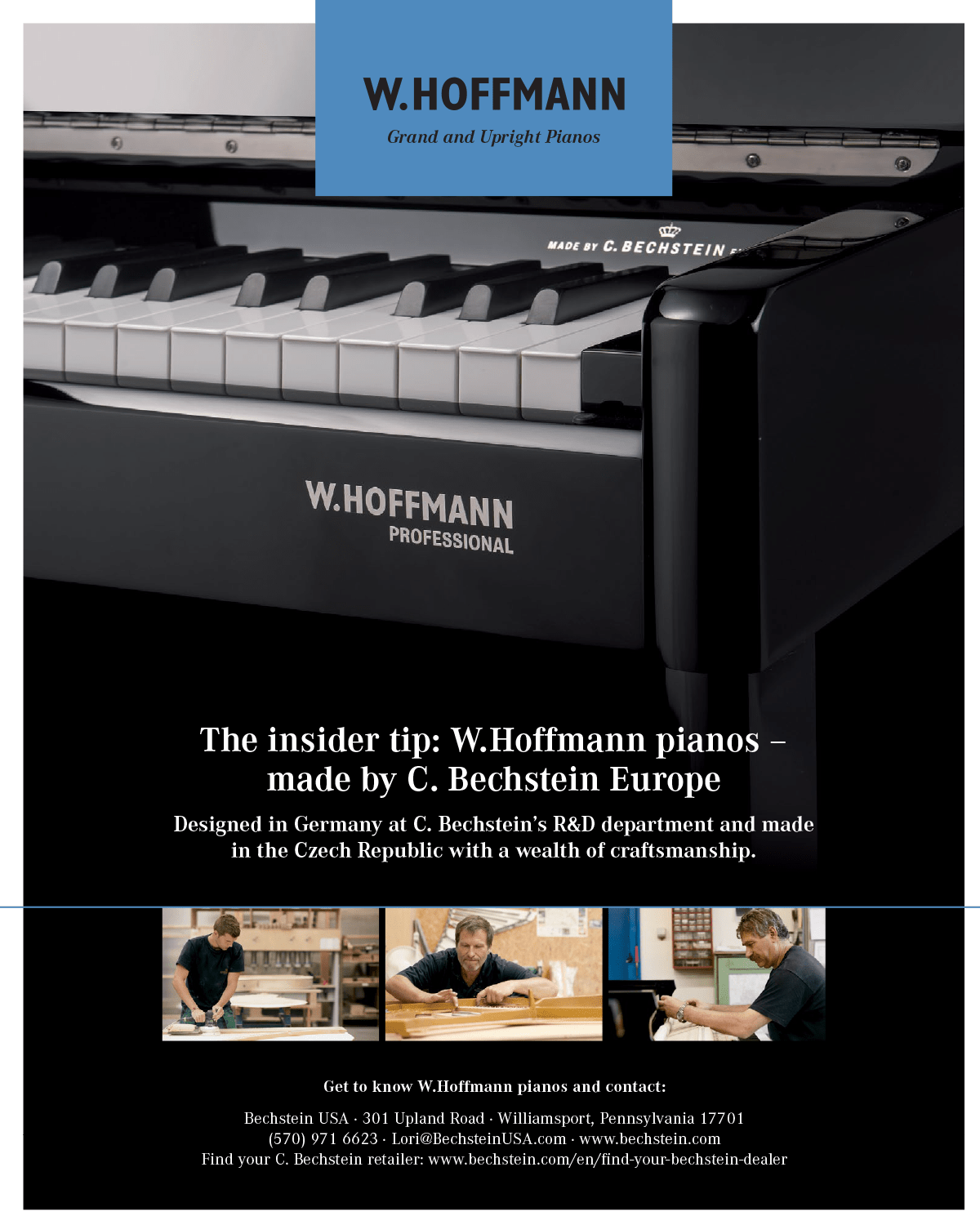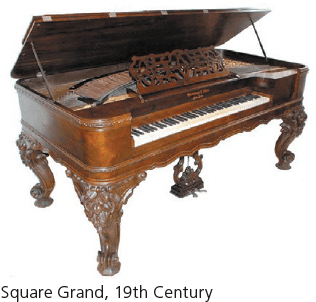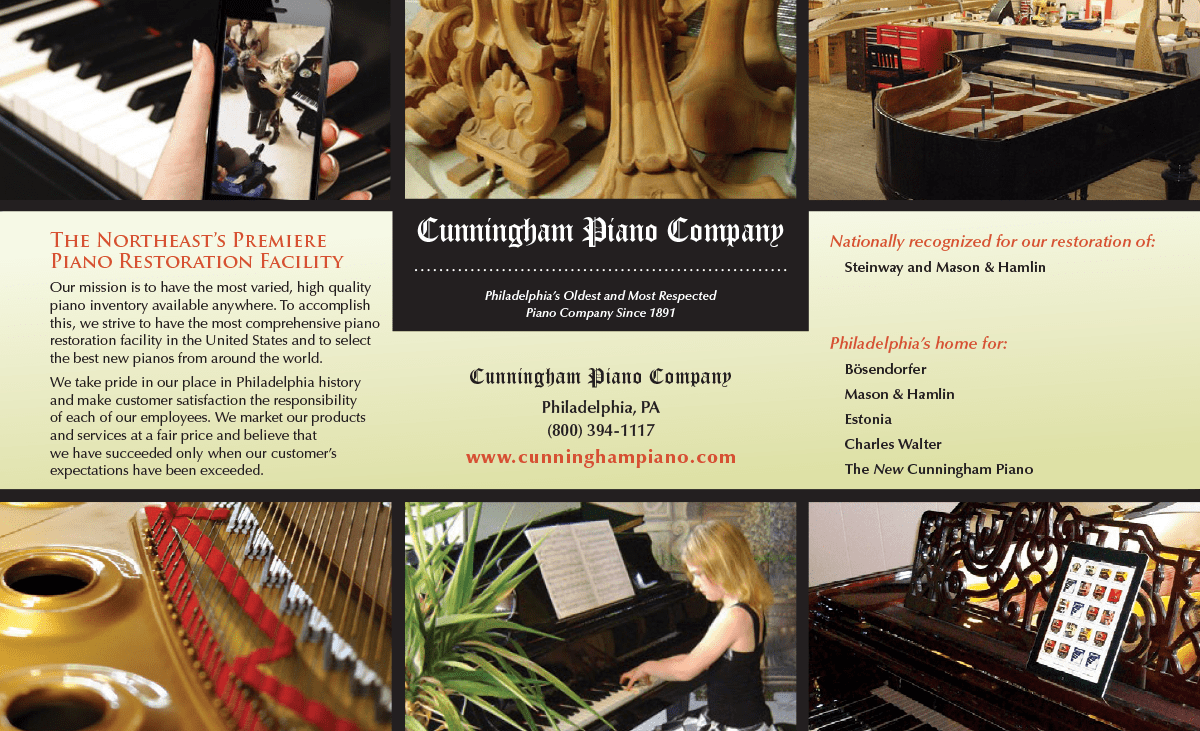
In the 1800s the piano spread more quickly through the middle classes, and across the ocean to North America. Riding along with the Industrial Revolution, piano-making evolved from a craft into an industry. Many important changes took place during the 19th century: The upright piano was invented; the modern grand piano action was invented, incorporating the best aspects of the previous rival actions; the cast-iron plate was invented, vastly strengthening the structure and allowing the strings to be stretched at a higher tension, thus increasing the power and volume of sound; the range of the instrument was extended from about five octaves to the present seven-plus octaves; and, toward the end of the century, the square piano died out, leaving just grands of various sizes and the full-size upright. By 1880, most of these changes were in place; the pianos made today are not very different from those of a hundred or more years ago.

In your search for a piano, you’re unlikely to run across instruments made before 1880, with two exceptions. The square piano, or square grand, as it is sometimes called, looks like a rectangular box on legs (see illustration), and was very popular as a home piano during the 19th century. Its ornate Victorian case makes very pretty furniture — but it also makes a terrible musical instrument for 21st-century playing and practicing. Tuning, servicing, and repair are difficult and expensive, very few piano technicians know how to do it, and parts are hard to come by. Even at their best, these instruments are unsuitable to practice on, even for beginners.
Another piano to avoid is a type of upright made primarily in Europe from the middle to the end of the 19th century. The dampers on these piano are positioned above the hammers and actuated by wires in front of the action — the reverse of a modern-day upright. This over-damper system has been nicknamed the “birdcage action” because the damper wires form an enclosure that resembles a bird cage. Besides being very difficult to tune and service through the “bird cage,” these pianos are usually so worn out that they won’t hold a tuning longer than about ten seconds, and their actions work erratically at best. Many of these pianos were cheaply made to begin with, but they often have ornate cabinets and fancy features, such as candlestick holders, that make them attractive to antique collectors.
Some of the well-regarded piano brand names of
the 1900-1930 period, in alphabetical order |
Apollo
Baldwin
Bechstein
Blüthner
Bösendorfer
A.B. Chase |
Chickering
Emerson
Everett
Haines Bros.
Hallet & Davis
Hamilton |
Heintzman
Hume
Ibach
Ivers & Pond
Jewett
Kimball |
Wm. Knabe
Krakauer
Lester
Mason & Hamlin
McPhail
Henry F. Miller |
Packard
Sohmer
Steinert
Steinway & Sons
Chas. Stieff
Vose & Sons |
Weber
Wing |
Although most pianos you’ll come across made prior to 1880 will have little practical or financial value, the few that have historical value are best left to specialists and collectors who can properly conserve them.

1880–1900
The years from 1880 to about 1900 were a transition period, as some old styles were slow to fade. But some pianos from this period may be suitable for you. A piano with only 85 instead of 88 notes may be perfectly satisfactory if you don’t anticipate ever needing the highest three notes. The resale value of such a piano may be slightly lower than its modern equivalent, but so should be the price you pay for it. A piano with an old-style cast-iron plate that, while extending the full length of the piano, leaves the pinblock exposed to view is, for all practical purposes, just as structurally sound as one in which the plate covers the pinblock. Avoid, however, the so-called “three-quarter-plate” piano, in which the plate ends just short of the pinblock. These pianos have a high rate of structural failure. Pianos with actions that are only very slight variations on modern actions are fine as long as the parts are not obsolete and absolutely unobtainable.
Most pianos this old will need a considerable amount of repair and restoration to be fully usable, so the best candidates from this period will be those instruments that justify the expense involved, such as Steinway, Mason & Hamlin, Bechstein, and Blüthner grands, or, in rare instances, a more ordinary brand that has been exceptionally well preserved. With occasional exceptions, the vast majority of uprights and cheaper grands that survive from this period are not worth repairing, unless for historical or sentimental reasons.
1900–1930
The period from about 1900 to 1930 was the heyday of piano manufacturing in America. The piano held an important place in the national economy and as a symbol of culture and social status. Hundreds of small firms turned out millions of pianos during this time; in fact, far more pianos were made annually then than are made today. If you’re shopping for a used full-size upright or a grand, some of the pianos you’ll see will probably be from this period. Smaller pianos weren’t introduced until later. Although some well-preserved instruments from this period may be usable as is, most will need rebuilding, or at least reconditioning.
Those in the market for a used piano often ask for recommendations of specific brands from this period. This is a problem, because the present condition of the piano, the kind of use you’ll be giving it, and the cost of the piano and repairs are far more important factors than the brand when considering the purchase of an old piano. Even a piano of the best brand, if poorly maintained or badly repaired, can be an unwise purchase. Time and wear are great levelers, and a piano of only average quality that has not been used much may be a much better buy. Nevertheless, since that answer never satisfies anyone, I offer a list (see box) of some of the brand names of the period that were most highly regarded. Please note that this list, which is by no means complete — or universally agreed on — applies only to pianos made before about 1930, since in many cases the same names were later applied to entirely different, usually lower, quality standards.
During this period, a large percentage of the pianos made were outfitted with pneumatically driven playerpiano systems. When these mechanisms eventually fell into dis-repair, they were often removed. Although there is still a small group of technicians and hobbyists dedicated to restoring these fascinating relics of the past, in most cases it is not economically practical to do so except for historical or sentimental reasons.
1930–1960
The rise of radio and talking pictures in the 1920s competed with pianos for the public’s attention and weakened the piano industry, and the Great Depression decimated it. During the Depression, many piano makers, both good and bad, went bankrupt, and their names were bought up by the surviving companies. Sometimes the defunct company’s designs continued to be used, but often only the name lived on. Still, piano making in the 1930s, though reduced in quantity from earlier years, was in most cases of a similar quality.
To revive the depressed piano market in the mid-1930s, piano makers came up with a new idea: the small piano. Despite the fact that small pianos, both vertical and grand, are musically inferior to larger ones, the public decided that spinets, consoles, and small grands were preferable because they looked better in the smaller homes and apartments of the day. There has always been a furniture aspect to the piano, but the degree to which piano makers catered to that aspect from the mid-’30s onward marked a revolution in piano marketing.
During World War II, many piano factories were commandeered to make airplane wings and other wartime products, and what piano making there was fell somewhat in quality because of a lack of good raw materials and skilled labor. Things changed for the better in the postwar period, and you’ll sometimes find used pianos from this period, still in reasonably good condition or needing some reconditioning, from such brands as Steinway, Baldwin, Mason & Hamlin, Sohmer, Everett, Knabe, and Wurlitzer.
1960–Present
In the 1960s, the Japanese began exporting pianos to the U.S. in large numbers. Although at first they had some difficulty building pianos to the demands of our climate, by the mid- to late-’60s their quality was so high and their prices so low that they threatened to put all U.S. makers out of business. In response, most of the mid-priced American makers cheapened their product to compete. As a result, the 20 years from about 1965 to 1985 are considered, from a quality standpoint, to be a low point in U.S. piano manufacturing. In any case, the Americans were unable to compete. The international takeover of the U.S. piano market accelerated in the 1980s as the Koreans began to export here, and by 1985 all but a few U.S. piano makers had gone out of business. As in an earlier period, some of their brand names were purchased and later used by others.
Please see the article “The New-Piano Market Today” for more information on the post-1960 period. See also the article “Advice About Used Pianos for Parents of Young Beginning Piano Students” for a list of specific brands of this period to avoid.
A used piano made within the past few decades can often be a very good deal, as these instruments may still show very few signs of age and wear, but with a price far below that of a new piano. The most recently made used pianos may even come with a warranty that is still in effect. Also, the influx of new, low-priced, Chinese- and Indonesian-made pianos has driven down the price of used pianos, in some cases rather substantially, as the imports offer the opportunity to buy a new piano for a price only a little higher than a decent used one previously commanded. If you’re considering a piano from this period, you may wish to read applicable articles in this publication about new pianos, as well as current and past editions of The Piano Book. See also the accompanying sidebar about so-called gray-market pianos.
Though in each decade both good and bad pianos have been produced, and each piano must be judged on its own merits, this brief historical overview may give you some idea of what to expect to see as you shop for a used piano. You can determine the age of a piano by finding its serial number (The Piano Book tells how) and looking it up in the Pierce Piano Atlas (www.piercepianoatlas.com), or perhaps by asking a piano dealer or technician to look it up for you. You can also consult our article or our video for instructions on how to locate the serial number.
Gray-Market Pianos
If you’re looking for a piano made within the last few decades, there is usually a plentiful supply of used Yamaha and Kawai pianos originally made for the Japanese market. However, there has been some controversy about them. Sometimes called “gray-market” pianos, these instruments were originally sold to families and schools in Japan, and some years later were discarded in favor of new pianos. There being little market for these used pianos in Japan — the Japanese are said to have a cultural bias against buying any used goods — enterprising businesspeople buy them up, restore them to varying degrees, and export them to the U.S. and other countries, where they are sold by dealers of used pianos at prices significantly lower than those of new Yamahas or Kawais. Used Korean pianos are available under similar circumstances. (Note: The term “gray market” is used somewhat erroneously to describe these pianos. They are used instruments, not new, and there is nothing illegal about buying and selling them.)
Yamaha has taken a public stand warning against the purchase of a used Yamaha piano made for the Japanese market. When Yamaha first began exporting pianos to the United States, the company found that some pianos sent to areas of the U.S. with very dry indoor climates, such as parts of the desert Southwest and places that were bitterly cold in the winter, would develop problems in a short period of time: tuning pins would become loose, soundboards and bridges would crack, and glue joints would come apart. To protect against this happening, Yamaha began to season the wood for destination: a low moisture content for pianos bound for the U.S., which has the greatest extremes of dryness; a higher moisture content for Europe; and the highest moisture content for Japan, which is relatively humid. The gray-market pianos, Yamaha says, having been seasoned for the relatively humid Japanese climate, will not stand up to our dryness. The company claims to have received many calls from dissatisfied owners of these pianos, but cannot help them because the warranty, in addition to having expired, is effective only in the country in which the piano was originally sold when new.
My own research has led me to believe that while there is some basis for Yamaha’s concerns, their warnings are somewhat exaggerated. There probably is a greater chance, statistically, that these pianos will develop problems in conditions of extreme dryness than will Yamahas seasoned for and sold in the U.S. However, thousands of gray-market pianos have been sold by hundreds of dealers throughout the country, in all types of climates, for many years, and, while there have been problems, particularly in sections of the country with temperature and humidity extremes, I haven’t found evidence of anything close to an epidemic. In mild and moderate climates, reported problems are rare. There are, however, some precautions that should be taken.
These pianos are available to dealers in a wide variety of ages and conditions. The better dealers will sell only those in good condition made since about the mid-1980s. In some cases, the dealers or their suppliers will recondition or partially rebuild the pianos before offering them for sale. Make sure to get a warranty that runs for at least five years, as any problems will usually show up within that period if they are going to show up at all. Finally, be sure to use some kind of humidity-control system in situations of unusual dryness. Remember that air-conditioning, as well as heating, can cause indoor dryness.
It’s not always possible to determine visually whether a particular instrument was made for the U.S. or the Japanese market, as some original differences may have been altered by the supplier. The dealer may know, and Yamaha has a utility on its website that will look up the origin of a particular Yamaha piano by serial number.